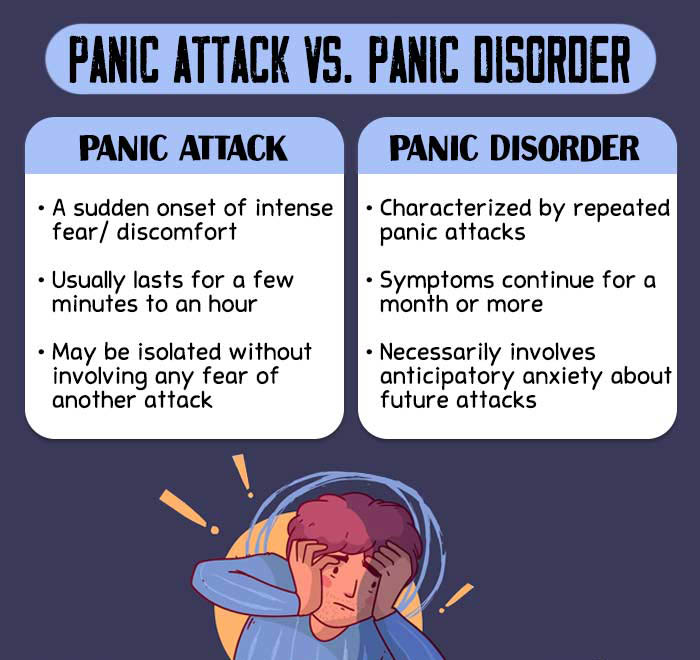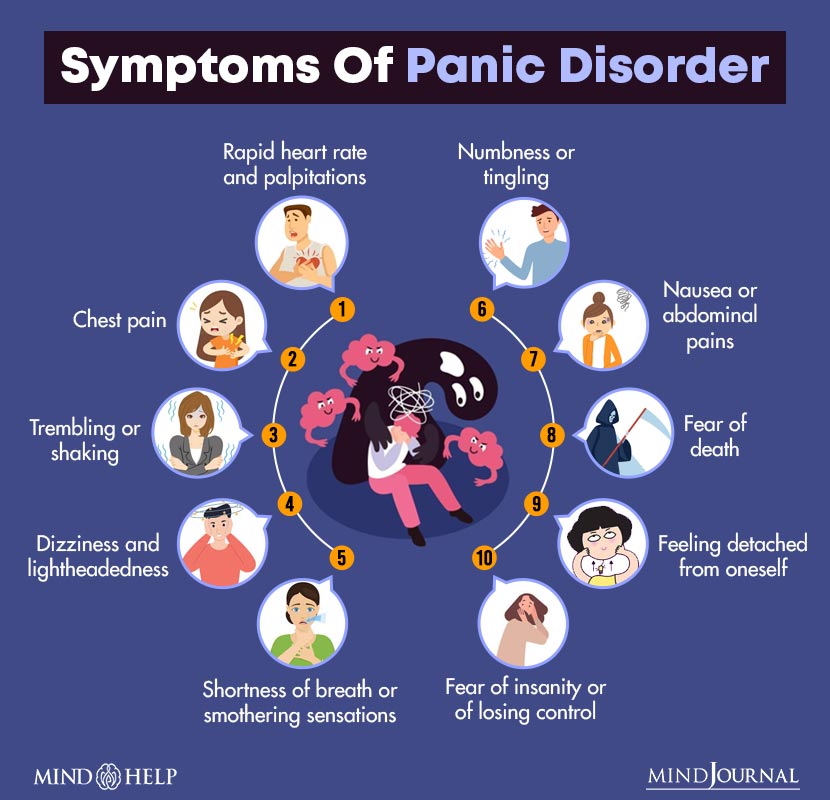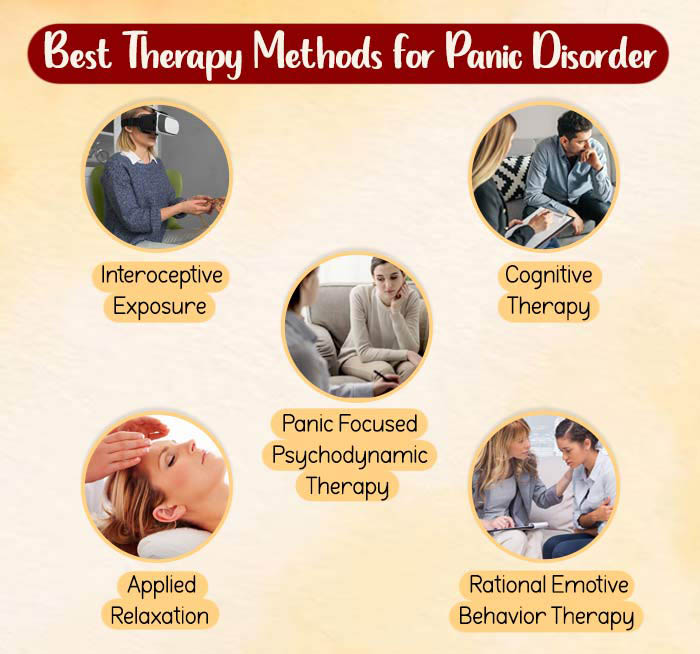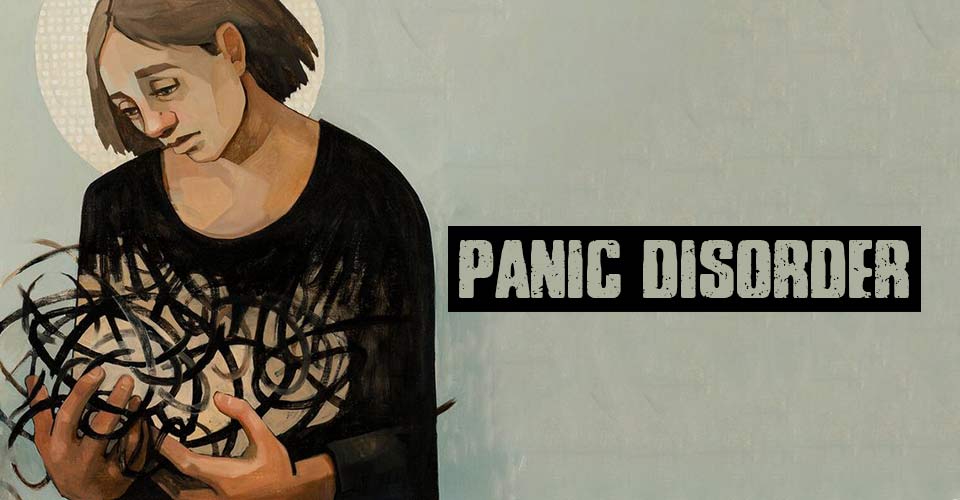Panic disorder is a mental illness involving two or more panic attacks and constant fear of subsequent attacks. Repeated panic attacks can adversely affect your life and well-being. If left untreated, panic disorder can prove to be quite debilitating.
What Is Panic Disorder?
Panic disorder is a form of anxiety disorder involving frequent, recurring panic attacks in random situations [mfn] National Institute of Mental Health. (2016). NIMH» Panic Disorder: When Fear Overwhelms. Www.nimh.nih.gov. Available from: https://www.nimh.nih.gov/health/publications/panic-disorder-when-fear-overwhelms [/mfn] and fear of such attacks occurring again. Some people may have one or two attacks in a month, while others may experience them multiple times in a week.
People suffering from panic disorder can even develop an aversion to certain places or situations that they consider to be possible triggers for their attacks.
What is a panic attack?
Panic attacks are characterized by a sudden and rapid onset of symptoms like numbness, trembling, sweating, shortness of breath, palpitations, and fear of dying. They usually peak in a span of ten minutes [mfn] Bighelli, I., Castellazzi, M., Cipriani, A., Girlanda, F., Guaiana, G., Koesters, M., Turrini, G., Furukawa, T. A., & Barbui, C. (2018). Antidepressants versus placebo for panic disorder in adults. The Cochrane database of systematic reviews, 4(4), CD010676. https://doi.org/10.1002/14651858.CD010676.pub2 [/mfn].
Panic attack vs. Panic disorder
If you experience a panic attack, it does not necessarily mean that you have panic disorder [mfn] Fontaine, R., & Beaudry, P. (1984). Panic attacks and panic disorders. Canadian family physician Medecin de famille canadien, 30, 1383–1388. [/mfn], as panic attacks can occur due to a variety of reasons. However, when these panic attacks are recurring and unpredictable and you constantly fear them, you are likely suffering from panic disorder.

Panic disorder vs. Anxiety
Panic disorder is a type of anxiety disorder. However, not all people with anxiety experience panic attacks. Examples of other anxiety-related conditions include generalized anxiety disorder, social anxiety disorder, and obsessive-compulsive disorder, among others.
Read More About Anxiety Here
Panic attacks in other disorders
While panic attacks are also characteristic of other anxiety disorders such as specific phobias, social anxiety disorder, and agoraphobia, what distinguishes panic disorder from the others is the fact that the attacks have no specific triggers and the situations in which they might occur are unpredictable, differing from person to person.
Read More About Social Anxiety Disorder Here
According to the American Psychological Association (APA [mfn] American Psychological Association. (2022, June 28). Panic Disorder: Answers to your most important questions. Available from: https://www.apa.org/topics/anxiety/panic-disorder [/mfn]), 1 out of every 75 people may experience panic disorder, usually during their teens or early adulthood. It generally peaks in adulthood. Moreover, women are twice as likely to develop this condition as men.
Panic disorder is considered to be one of the most common mental disorders [mfn] Taylor C. B. (2006). Panic disorder. BMJ (Clinical research ed.), 332(7547), 951–955. https://doi.org/10.1136/bmj.332.7547.951 [/mfn] and it is frequently associated with other disorders such as depression.
Case Example
Neil initially consulted his physician complaining of frequent attacks of what seemed like asthma. He said that this was the first time something like this was happening to him and he could not predict when the attacks would occur. As a result, he would remain preoccupied with the possibility of one occurring throughout the day.
Neil would suddenly start running out of breath, sweating, and palpitating with no apparent trigger. “I feel so terrified all of a sudden… sometimes it seems as though I am dying,” he said.
This started to affect his social life because he had been avoiding going out to parties and get-togethers for fear of unintentionally ‘creating a scene.’
Case Analysis
It can sometimes be difficult to distinguish asthma from panic. However, from Neil’s symptoms, it is evident that he had been experiencing frequent bouts of extreme fear along with other physical symptoms that are characteristic of a panic attack.
Moreover, he also seemed to be in constant anticipation of another attack while avoiding social situations where he thought it might occur, which is indicative of panic disorder.
Take This Panic Disorder Test Here
Symptoms Of Panic Disorder
The sooner you identify the symptoms of a disorder, the faster you can get help. Here are the 3 main signs [mfn] National Institute of Mental Health. (2016). NIMH» Panic Disorder: When Fear Overwhelms. Www.nimh.nih.gov. Available from: https://www.nimh.nih.gov/health/publications/panic-disorder-when-fear-overwhelms [/mfn] of panic disorder for you to look out for:
- Sudden and recurring panic attacks involving extreme fear
- A feeling of impending doom during panic attacks
- Constant worry and preoccupation with the possibility of another attack
The following symptoms are common during a panic attack:
- Palpitations or increased heartbeat
- Sweating
- Trembling or shaking
- Shortness of breath
- Feeling of choking
- Chest pain or discomfort
- Nausea
- Dizziness or fainting
- Feeling detached from reality or self
- Fear of losing control or
- Fear of dying
- Numbness or tingling sensations
- Chills or hot flushes.
Panic attacks may look different for different people. Not every person has all of the symptoms.

Types Of Panic Disorder
Irrespective of how the symptoms may manifest, they are usually diagnosed under the umbrella of panic disorder. However, experts have suggested 4 clinical types [mfn] Takeuchi, T., Hasegawa, M., Ikeda, M., Hayashi, R., Tomiyama, G., Nemoto, T., & Hoshino, K. (1992). Four clinical types of panic disorders. The Japanese journal of psychiatry and neurology, 46(1), 37–44. https://doi.org/10.1111/j.1440-1819.1992.tb00817.x [/mfn] of panic disorder:
Type I: In this type, a single panic attack is the only symptom. Since the occurrence of one panic attack is not sufficient for the diagnosis of panic disorder, this type is also known as ‘incomplete panic disorder’.
Type II: In the second type, panic attacks occur repeatedly but other symptoms of anxiety are absent in the period between two panic attacks. There is also an absence of any other co-occurring disorder such as depression.
Type III: This is the most common type of panic disorder and the one usually regarded in modern diagnoses. This type of panic disorder not only includes recurring panic attacks but accompanying anticipatory anxiety as well. It is also common for agoraphobia and somatoform disorders to occur along with this type.
Read More About Agoraphobia Here
Type IV: This type of panic disorder co-occurs with depression. It must be noted, however, that the symptoms of depression develop after that of panic disorder. In the case of the opposite, depression would be diagnosed.
Read More About Depression Here
Causes Of Panic Disorder
Researchers believe that many factors can contribute to the development of panic disorder.
Let us take a look at what causes panic disorder:
- Genetic [mfn] Cackovic, C., Nazir, S., & Marwaha, R. (2022). Panic Disorder. In StatPearls. StatPearls Publishing. Available from: https://www.ncbi.nlm.nih.gov/books/NBK430973/ [/mfn] vulnerability
- Dysfunction of brain areas such as the amygdala [mfn] Reiman, E. M., Raichle, M. E., Butler, F. K., Herscovitch, P., & Robins, E. (1984). A focal brain abnormality in panic disorder, a severe form of anxiety. Nature, 310(5979), 683–685. https://doi.org/10.1038/310683a0 [/mfn]
- Adverse childhood experiences [mfn] Kolek, A., Prasko, J., Vanek, J., Kantor, K., Holubova, M., Slepecky, M., Nesnidal, V., Latalova, K., Ociskova, M., & Grambal, A. (2019). Severity of panic disorder, adverse events in childhood, dissociation, self-stigma and comorbid personality disorders Part 1: Relationships between clinical, psychosocial and demographic factors in pharmacoresistant panic disorder patients. Neuro endocrinology letters, 40(5), 233–246. [/mfn]
- Temperament traits [mfn] Izci, F., Gültekin, B. K., Saglam, S., Koc, M. I., Zincir, S. B., & Atmaca, M. (2014). Temperament, character traits, and alexithymia in patients with panic disorder. Neuropsychiatric disease and treatment, 10, 879–885. https://doi.org/10.2147/NDT.S62647 [/mfn] (eg: high harm avoidance and low self-directedness)
- Stressful events [mfn] Falsetti, S. A., Resnick, H. S., Dansky, B. S., Lydiard, R. B., & Kilpatrick, D. G. (1995). The relationship of stress to panic disorder: Cause or effect? In C. M. Mazure (Ed.), Does stress cause psychiatric illness? (pp. 111–147). American Psychiatric Association. Available from: https://psycnet.apa.org/record/1994-98814-005 [/mfn] or trauma
- Major changes in life
- History of childhood abuse
- Excessive nicotine or caffeine [mfn] Vilarim, M. M., Rocha Araujo, D. M., & Nardi, A. E. (2011). Caffeine challenge test and panic disorder: a systematic literature review. Expert review of neurotherapeutics, 11(8), 1185–1195. https://doi.org/10.1586/ern.11.83 [/mfn] intake
Panic Disorder Diagnosis
According to the fifth edition of the Diagnostic and Statistical Manual of Mental Disorders (DSM-5 [mfn] APA. (2013). DSM-5. Psychiatry.org; American Psychiatric Association. Available from: https://www.psychiatry.org/psychiatrists/practice/dsm [/mfn]), a person must experience more than one panic attack characterized by 4 or more of the symptoms mentioned before, along with the following symptoms persisting for a month or more to be diagnosed with panic disorder:
- Persistent worry about attacks occurring in future
- Concern regarding the aftermath and consequences of having a panic attack
- A significant change in behavior related to the panic
If the symptoms or panic attacks are caused by other factors such as illnesses or the use of medications and substances, then it may not be diagnosed as panic disorder.
A mental health professional usually takes a detailed history of the symptoms along with other details related to the personal and family history before arriving at a diagnosis. Psychometric tests such as the Panic Disorder Severity Scale (PDSS [mfn] Shear, M. K., Rucci, P., Williams, J., Frank, E., Grochocinski, V., Vander Bilt, J., Houck, P., & Wang, T. (2001). Reliability and validity of the Panic Disorder Severity Scale: replication and extension. Journal of psychiatric research, 35(5), 293–296. https://doi.org/10.1016/s0022-3956(01)00028-0 [/mfn]) are sometimes used by clinicians to assess the symptoms of the disorder.
Treatment Of Panic Disorder
Experts agree that a combination of psychotherapy and medication can help reduce panic attacks. Most patients experience substantial progress within a few weeks of treatment.
Let us look at how to treat panic disorder as per different approaches:
1. Psychotherapy
Some therapeutic techniques commonly used to treat panic disorder are:
Cognitive Therapy (CT)
Cognitive therapy (CT) is widely considered the first-line treatment [mfn] Kim Y. K. (2019). Panic Disorder: Current Research and Management Approaches. Psychiatry investigation, 16(1), 1–3. https://doi.org/10.30773/pi.2019.01.08 [/mfn] for managing panic disorder. It helps to change unhealthy or maladaptive thoughts and reactions and gain a better understanding and control of the triggers for panic attacks.
Learn About Cognitive Behavioral Therapy Here
Interoceptive Exposure (IE)
IE has been found to be as effective [mfn] Arntz A. (2002). Cognitive therapy versus interoceptive exposure as treatment of panic disorder without agoraphobia. Behaviour research and therapy, 40(3), 325–341. https://doi.org/10.1016/s0005-7967(01)00014-6 [/mfn] as cognitive therapy, especially in treating panic disorder. Sometimes the two can go hand-in-hand, although interoceptive exposure is usually the step after CT. IE works on the principle that it is possible to reduce fear responses in people by exposing them to their bodily sensations for a prolonged period.
Panic-focused Psychodynamic Psychotherapy (PFPP)
Cognitive and behavioral techniques may not be effective for everyone and have resulted in a relapse in a lot of patients. Thus, short-term psychodynamic therapy techniques such as PFPP [mfn] Beutel, M. E., Scheurich, V., Knebel, A., Michal, M., Wiltink, J., Graf-Morgenstern, M., Tschan, R., Milrod, B., Wellek, S., & Subic-Wrana, C. (2013). Implementing panic-focused psychodynamic psychotherapy into clinical practice. Canadian journal of psychiatry. Revue canadienne de psychiatrie, 58(6), 326–334. https://doi.org/10.1177/070674371305800604 [/mfn] have been developed to address the underlying issues that may cause panic disorder. Follow-ups after PFPP have mostly been positive.
Applied Relaxation (AR)
AR is a well-established relaxation technique [mfn] Ost, L. G., & Westling, B. E. (1995). Applied relaxation vs cognitive behavior therapy in the treatment of panic disorder. Behaviour research and therapy, 33(2), 145–158. https://doi.org/10.1016/0005-7967(94)e0026-f [/mfn] for panic disorder. It has been found to have equally good results as cognitive therapy and is more effective than other methods of relaxation such as progressive muscle relaxation (PMR).
Other therapy methods include:
- Cognitive behavior therapy (CBT)
- Rational Emotive Behavior Therapy (REBT)
- Cognitive Behavior Modification (CBM), etc.
For several patients, a combination of these therapy techniques, along with medication and lifestyle changes, may prove to be the most effective approach.

2. Medications
Severe panic disorder often warrants medication and sometimes hospitalization. Some common types of medication prescribed for this condition include:
- SSRIs & SNRIs [mfn] Andrisano, C., Chiesa, A., & Serretti, A. (2013). Newer antidepressants and panic disorder: a meta-analysis. International clinical psychopharmacology, 28(1), 33–45. https://doi.org/10.1097/YIC.0b013e32835a5d2e [/mfn]
- Beta-blockers
- Benzodiazepines [mfn] Pull, C. B., & Damsa, C. (2008). Pharmacotherapy of panic disorder. Neuropsychiatric disease and treatment, 4(4), 779–795. https://doi.org/10.2147/ndt.s1224 [/mfn]
- Atypical antipsychotics [mfn] Zulfarina, M. S., Syarifah-Noratiqah, S. B., Nazrun, S. A., Sharif, R., & Naina-Mohamed, I. (2019). Pharmacological Therapy in Panic Disorder: Current Guidelines and Novel Drugs Discovery for Treatment-resistant Patient. Clinical psychopharmacology and neuroscience : the official scientific journal of the Korean College of Neuropsychopharmacology, 17(2), 145–154. https://doi.org/10.9758/cpn.2019.17.2.145 [/mfn], etc.
Tips To Cope With Panic Disorder
There are no guaranteed ways to prevent panic attacks. However, certain strategies can be adopted for coping with panic disorder, along with professional treatment.
- Exercising regularly
- Practicing relaxation techniques like deep breathing, mindfulness meditation [mfn] Hoge, E. A., Bui, E., Marques, L., Metcalf, C. A., Morris, L. K., Robinaugh, D. J., Worthington, J. J., Pollack, M. H., & Simon, N. M. (2013). Randomized controlled trial of mindfulness meditation for generalized anxiety disorder: effects on anxiety and stress reactivity. The Journal of clinical psychiatry, 74(8), 786–792. https://doi.org/10.4088/JCP.12m08083 [/mfn], and yoga
- Avoiding nicotine, caffeine, alcohol, and illicit drugs
- Following a nutritious diet & avoiding sugary food
- Getting good sleep
- Having a support system and regularly communicating your feelings
Takeaway
Around 30-40% of patients who seek treatment for panic disorder recover fully for extended periods. Moreover, around 50% of patients experience only mild symptoms which don’t affect their lives on a daily basis.
If you or your loved ones are suffering from panic disorder, remember that it is possible to get better. Seeking treatment and making some lifestyle changes can not only help you overcome the symptoms but also empower you to live a healthier, happier life.
At A Glance
- Panic disorder can make you feel overwhelmed, anxious and terrified even in the absence of any obvious threats.
- Most people experience at least one or two panic attacks in their lives which may last for 5-20 minutes.
- Symptoms of panic disorder are a racing heart, chest pain, sweating, shaking, dizziness, flushing, stomach churning, faintness, and breathlessness
- Adverse childhood conditions like poverty and physical, emotional, or sexual abuse may cause panic disorder in adulthood.
- A combination of psychotherapy under a qualified professional and medication can help reduce anxiety and panic attacks.
Frequently Answered Questions (FAQs)
1. Is panic disorder curable?
Yes. Panic disorder can be effectively treated using psychotherapy or medication.
2. Who are the celebrities with panic disorder?
Some famous people known to have suffered from panic attacks are Princess Diana and Oprah Winfrey.
3. What is the best treatment for panic disorder?
Panic disorder is usually treated with psychotherapy, eg. cognitive therapy, interoceptive exposure therapy, and applied relaxation.











Leave a Reply